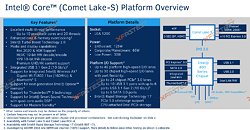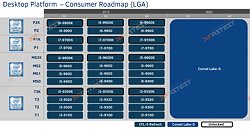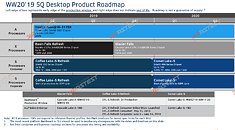Thursday, July 11th 2019

Intel "Comet Lake" Not Before 2020, "Ice Lake-S" Not Before Q3-2020, Roadmap Suggests
Earlier this week, news of Intel's 10th generation Core "Comet Lake" processors did rounds as the company's short-term response to AMD's 3rd generation Ryzen processors. According to slides leaked to the web by Hong Kong-based tech publication XFastest, "Comet Lake" isn't Intel's short-term reaction to "Zen 2," but rather all it has left to launch. These processors won't launch before 2020, the slide suggests, meaning that AMD will enjoy a free rein over the processor market until the turn of the year, including the all-important Holday shopping season.
More importantly, the slide suggests that "Comet Lake" will have a market presence spanning Q1 and Q2 2020, meaning that the 10 nm "Ice Lake" won't arrive on the desktop platform until at least Q3 2020. It's likely that the LGA1200 platform which debuts with "Comet Lake" will extend to "Ice Lake," so consumers aren't forced to buy a new motherboard within a span of six months. The platform diagram put out in another slide junks the idea of an on-package MCM of the processor and PCH dies (which was likely ripped off from the "Ice Lake-Y" MCM platform diagram).The new platform combines a "Comet Lake" processor with an Intel 400-series PCH, which talk to each other over DMI 3.0, which offers comparable bandwidth PCI-Express 3.0 x4. The AMD "Valhalla" platform implements PCI-Express 4.0 x4 between the SoC and X570 chipset. The platform's main PCI-Express x16 slot will remain gen 3.0.
Intel appears to have put much of its efforts into improving its 14 nanometer node one last time, and increasing core-counts with the introduction of a new 10-core silicon that does away with iGPU. With its "Skylake" core IPC within 5% of that of "Zen 2," and gaming performance leadership still held onto by a hair's breadth, Intel will focus on bolstering multi-thread performance by enabling HyperThreading on even its Core i5 and Core i3 desktop processor models, while providing more cores to the Dollar compared to its 9th generation "Coffee Lake Refresh."
The Core i3 series will be 4-core/8-thread, the Core i5 series 6-core/12-thread, the Core i7 series 8-core/16-thread, and the flagship Core i9 series 10-core/20-thread. Intel will leverage its refined 14 nm node to increase clock-speeds across the board, with its 10-core silicon having a TDP rating of 125 W, and not the 105 W we saw the other day. The Gen 9.5 iGPU on the 4/6/8-core models will be bolstered with more features via software, and be branded under the UHD 700-series.
With its mainstream desktop platform embattled, Intel will try to appease the PC enthusiast crowd by launching a new HEDT (high-end desktop) platform based on "Cascade Lake," codenamed "Glacial Falls," by Q4-2019. The new 14 nm "Cascade Lake-X" processor will be compatible with existing X299 chipset motherboards via a BIOS update, offer CPU core-counts of up to 18, TDP of up to 165 W, and increased performance via higher clock-speeds. It will compete with AMD's existing 2nd generation Ryzen Threadripper family. AMD's plans for a 3rd generation Threadripper based on the "Rome" MCM is on the back-burner even if not dead, with the company focusing on making sure it sells the high-margin 2nd generation EPYC processor in adequate volumes.
Source:
XFastest
More importantly, the slide suggests that "Comet Lake" will have a market presence spanning Q1 and Q2 2020, meaning that the 10 nm "Ice Lake" won't arrive on the desktop platform until at least Q3 2020. It's likely that the LGA1200 platform which debuts with "Comet Lake" will extend to "Ice Lake," so consumers aren't forced to buy a new motherboard within a span of six months. The platform diagram put out in another slide junks the idea of an on-package MCM of the processor and PCH dies (which was likely ripped off from the "Ice Lake-Y" MCM platform diagram).The new platform combines a "Comet Lake" processor with an Intel 400-series PCH, which talk to each other over DMI 3.0, which offers comparable bandwidth PCI-Express 3.0 x4. The AMD "Valhalla" platform implements PCI-Express 4.0 x4 between the SoC and X570 chipset. The platform's main PCI-Express x16 slot will remain gen 3.0.
Intel appears to have put much of its efforts into improving its 14 nanometer node one last time, and increasing core-counts with the introduction of a new 10-core silicon that does away with iGPU. With its "Skylake" core IPC within 5% of that of "Zen 2," and gaming performance leadership still held onto by a hair's breadth, Intel will focus on bolstering multi-thread performance by enabling HyperThreading on even its Core i5 and Core i3 desktop processor models, while providing more cores to the Dollar compared to its 9th generation "Coffee Lake Refresh."
The Core i3 series will be 4-core/8-thread, the Core i5 series 6-core/12-thread, the Core i7 series 8-core/16-thread, and the flagship Core i9 series 10-core/20-thread. Intel will leverage its refined 14 nm node to increase clock-speeds across the board, with its 10-core silicon having a TDP rating of 125 W, and not the 105 W we saw the other day. The Gen 9.5 iGPU on the 4/6/8-core models will be bolstered with more features via software, and be branded under the UHD 700-series.
With its mainstream desktop platform embattled, Intel will try to appease the PC enthusiast crowd by launching a new HEDT (high-end desktop) platform based on "Cascade Lake," codenamed "Glacial Falls," by Q4-2019. The new 14 nm "Cascade Lake-X" processor will be compatible with existing X299 chipset motherboards via a BIOS update, offer CPU core-counts of up to 18, TDP of up to 165 W, and increased performance via higher clock-speeds. It will compete with AMD's existing 2nd generation Ryzen Threadripper family. AMD's plans for a 3rd generation Threadripper based on the "Rome" MCM is on the back-burner even if not dead, with the company focusing on making sure it sells the high-margin 2nd generation EPYC processor in adequate volumes.



98 Comments on Intel "Comet Lake" Not Before 2020, "Ice Lake-S" Not Before Q3-2020, Roadmap Suggests
This rush to always be ahead in every metric possible is stupid.
As long as they remain competitive with 4-, 6- and 8-cores, they will have a solid market share in the consumer market. In terms of revenue in the desktop, laptop and server markets, Intel will remain strong for the next couple of years. The only markets where Intel will "struggle" is in the upper mainstream market (custom builders) and HEDT. These are products with very good margins, but the total revenue is not huge, but these are the markets that matters the most for "everyone" in this forum.
Even if the mainstream lineup of Intel is stuck on 14nm until 2021, the situation isn't as dire as you may think. At least until Zen 3 arrives, Intel have excellent per core performance, and as long as they keep that edge they will be fine. While AMD have an edge in efficiency and higher core counts, most buyers in this segment don't need more than 8 cores.
I surely hope that Intel make better backup plans for the next few years, not to keep market shares, I welcome a more split market, but to push the technology forward. Because that's the biggest tragedy of Intel's 10nm problems; they have a newer and much faster architecture, but just can't make it in greater volumes, so the market stagnates. Even with Intel being stuck at 14nm for now, they could have been in a much better position if they had made a backup plan. If Sunny Cove was also developed for 14nm, they didn't have to chase the 5 GHz boost, and could have had a much higher performing 8-core than right now, with a slightly larger die but better thermals.
As for the "stop-gap" Comet Lake, we don't know much of the finer details. But we do know Intel have excellent per core performance, but falls a little off with heavy multithreaded workloads. Comet Lake is rumored to feature better core-to-core bandwidth, it may get higher base clocks (Cascade Lake-X does ~4 GHz base on 10 cores, so why not?), and hopefully more individual boosting of cores (which is one of AMD's advantages right now), which should be enough to stay relevant up to 8-cores until Zen 3 arrives.
A side note is that Intel did some improvements in Cannon Lake, I wonder why they haven't backported that to other Skylake designs yet.
store.steampowered.com/hwsurvey/cpus/
But the 6 and 8 cores are rising in share.
It is still hard to justify an eight core cpu today if you only play on it. I tried to find people to reproduce a problem with my 9900K CPU. Not many have one.
Intel will be fine for now with the lower core count CPU. And i find it interesting that they are are allowing Hyperthreading on the i5 CPUs in the upcoming releases.
I wonder if they will have an answer for the AMD APUs at some point. For most people it seems a CPU with a reasonable integrated GPU is enough to game on.
Gaming is basically the one and only reason to buy an mid to High-end Intel CPU right now, and that's for less than 10% more FPS on average at 720p with a $1,300 GPU, while costing well over 10% more(3600 = $200 cooler included vs 9600k = $250+$20-$40(cooler) = $270-290).
I still used a quad-core last year (7600K and even upgraded to 7700K) and now with Ryzen 5, there's no going back anymore.
Get your act together, Intel!
Threadripper 3 FTW
75 mm2 chiplet contains 4800 Mtr which is barely 64 Mtr/mm2 how can you even claim this is 7nm.. and NAVI is even worse than 10nm by tsmc with 10300/251=41 Mtr/mm2
so the Comedy lake can stay on 14nm - 44 Mtr/mm2 density for many years, there will be 65 watt 8 core mainstream boosting to 4.2Ghz on low voltage 175 mm2 sized die that is all I need for homePC for the next decade, compared to amd chiplet of 75mm2 7nm plus 100mm2 12nm I/O chip that looks a bit messy to be fair and offers the same thing more or less. But I will wait for the 7nm by intel how ever long it takes must resist.
Density claims from foundries has a lot of marketing in it. Density depends a lot on what exactly is on the chip. SRAM is dense, logic - less so, IO doesn't scale down well to 7nm etc. High-performance versions of nodes are also much less dense than normal/mobile versions where top performance is less of a priority besides size (=cost) and efficiency (=power consumption/heat).
As far as architecture goes, Intel will follow the same ideas AMD has - more cache, wider CPU. We'll see what happens after that.13% IPC improvement AMD claims seems to be about right for the most painful areas (games and AVX productivity mainly). This is simply excellent.
Memory latency getting worse was very much a concious decision. They did not have to build - for example desktop - CPUs this way. This is simply a tradeoff for consolidating the chip manufacturing across the entire range of CPUs.